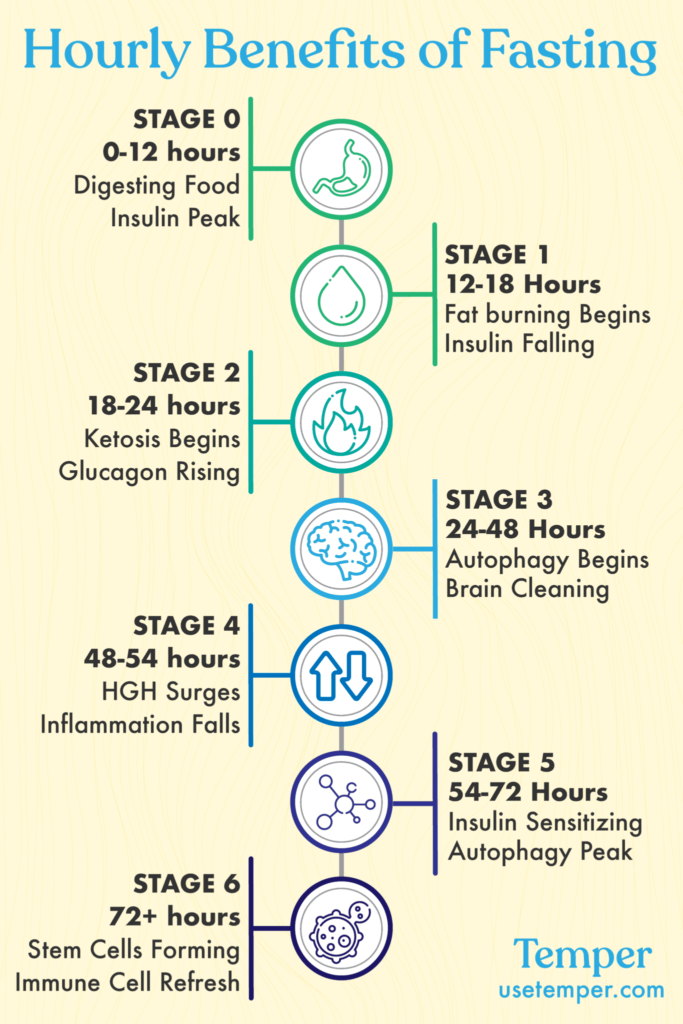Original Article Link
May 7, 2021 by Dr T. Dalton Combs PhD
With the recent skyrocketing popularity of intermittent fasting, the word “fasting” has stopped being associated exclusively with religion and protest and taken on a connection with an impressive list of health benefits including improved mood, increased energy, sharper focus, and even clearer skin.
So it’s no surprise that you might be curious about trying out fasting for yourself. But like the intelligent person you are, you first want to find out as much as you can about what fasting will do to your body and how it’ll make you feel.
Because knowledge is power, here is a detailed description of what happens during extended fasts, including the stages of fasting, what you can expect during them, and why.
What Is Extended Fasting?
There are a lot of different types of intermittent fasting. In some configurations, you’ll fast for no more than 12 hours. And on the upper limit of the timespan of fasting recommended for casual, less experienced fasters, is the 72-hour (3-day) fast, which is long enough to be considered an extended fast. As you go deeper into a fast, the effects stack.
Most of us have gone 12 or 16 or even 24 hours without eating at least a few times in our lives just out of necessity or coincidence, but it’s much less common for people to fast for three days unintentionally. So for this article, we’ll focus on what happens with your energy, metabolism, and general response to a 72-hour fast.
Stage One: 12 Hours
Typically, the human body’s main, preferred source of energy is glycogen, which is a stored form of glucose, a type of sugar you get from the carbohydrates you consume. When you digest your food, your body breaks down carbohydrates into glucose, which it stores as glycogen in the muscles and liver. As long as you have glycogen stored up, that’s what your body will use to give it the energy to function.
Now let’s talk hormones. In the few hours after eating, your insulin levels will rise, telling your body to break down glucose for energy. But after 12 hours of fasting, your insulin will drop. A hormone called leptin, which is responsible for telling you you’re full, will also fall, while ghrelin, the hormone that signals hunger, will rise.
Target these Stage One benefits with 16/8 fasting or 18/6 fasting.
Stage Two: 18 Hours
It takes between four and 18 hours of fasting for you to burn through your glycogen stores. Once that happens, your body needs to turn to an alternative source of fuel.
About four hours after you’ve stopped eating, your body will use a process called lipolysis for energy. Lipolysis breaks down the triglycerides – a type of lipid – in your fat cells to use a source of fuel. It will also break down amino acids (the compounds that form proteins) for energy.
But that will only last you so long. After about 18 hours of fasting, your body will transition into a state called ketosis, which is when it starts relying on fat as its primary form of energy. In the process of breaking down fat for fuel, your body will release ketones, or molecules that your liver produces from fatty acids.
At this stage, your insulin levels will remain low, but your glucagon – a hormone that controls blood sugar levels – will start to rise in order to prevent your blood glucose levels from dropping too low.
Target these Stage Two benefits with 18/6 fasting, OMAD fasting, or Eat-Stop-Eat fasting.
Find a healthy fasting practice you can stick to.
Stage Three: 24 Hours
After about 24 hours of fasting, your body starts to do something really interesting: repair itself. This is a process called autophagy, which is when your cells start to get rid of any components that are old, damaged, or functioning poorly.
Autophagy is incredibly important for your health and has been shown to reduce inflammation, kill cancer cells, and clear out the misfolded proteins that are thought to cause Alzheimer’s. As autophagy declines naturally with age, it’s thought that fasting-induced autophagy can be a way to reduce the effects of aging. And, indeed, studies have shown that fasting is connected to living a longer life.
Target these Stage Three benefits with ADF (Alternate Day Fasting), Eat-Stop-Eat fasting, or 5:2 fasting. Read a comparison.
Stage Four: 48 Hours
About 48 hours after beginning a fast, your body will go into a long-term fasting state. A few things will happen as a result.
First, your growth hormone levels will go up significantly, stimulating faster muscle repair and preserving lean muscle mass. This is thought to be related to ghrelin, the hunger hormone, which can promote growth hormone secretion.
Speaking of ghrelin: it will continue to rise and fall throughout the day but with lower and lower peaks, meaning that your hunger levels will even out throughout your fast.
Target these Stage Four benefits with Consecutive 5:2 fasting.
Stage Five: 54 Hours
At 54 hours, your insulin levels will be at their lowest point yet. Your ketone levels will increase further and, to prevent muscle breakdown, your body will break down branched-chain amino acids.
It’s worth noting the advantages of having your insulin levels this low. Insulin resistance, something that can happen as a result of having prolonged high levels of insulin, can lead to diabetes. In contrast, insulin sensitivity, which is what happens when you fast, can help you have a healthier body fat percentage, reduce inflammation, and activate further autophagy, the benefits of which you’ve read above.
Target these Stage Five benefits with Consecutive 5:2 fasting.
Stage Six: 72 Hours
Once you’ve gotten to the endpoint of your 72-hour fast, you’ll see one more benefit. At this stage in your fast, your IGF-1 (insulin-like growth factor), a hormone involved in growth and development, will decrease. This can trigger stem cell production, create new immune cells, and reduce oxidative stress, something that is thought to help with preventing aging and diseases like cancer.
How to Do an Extended Fast Safely
Before you get too excited about all of the health benefits of extended fasting, it is important to note that fasting for more than 24 or 48 hours is a serious undertaking that should be done carefully and ideally under medical supervision. If you’re interested in trying it out for yourself, here are some tips to help you stay as safe as possible.
- Stay hydrated! While your body can go 72 hours without food, you don’t want to deprive it for that long of electrolytes, which help you remain hydrated. To maintain your electrolyte levels, you can take an electrolyte supplement or consume salt in your water.
- Have a plan for how you’ll break your fast. Bone broth, which is thought to be immune-boosting, anti-inflammatory, and easy on your stomach is a common choice.
- Speak to your doctor. A medical professional who can consult you on your specific case is ultimately the best person to guide you through a fast.
Not sure what style of fasting is best for you?
Take our fasting style quiz .
Further Reading
- Uddin, Md. S., Stachowiak, A., Mamun, A. A., Tzvetkov, N. T., Takeda, S., Atanasov, A. G., Bergantin, L. B., Abdel-Daim, M. M., & Stankiewicz, A. M. (2018). Autophagy and Alzheimer’s Disease: From Molecular Mechanisms to Therapeutic Implications. Frontiers in Aging Neuroscience, 10, 04. https://www.ncbi.nlm.nih.gov/pmc/articles/PMC5797541/
- Anton, S. D., Moehl, K., Donahoo, W. T., Marosi, K., Lee, S. A., Mainous, A. G., Leeuwenburgh, C., & Mattson, M. P. (2018). Flipping the Metabolic Switch: Understanding and Applying the Health Benefits of Fasting: Flipping the Metabolic Switch. Obesity, 26(2), 254–268. https://www.ncbi.nlm.nih.gov/pmc/articles/PMC5783752/
- Finnell, J. S., Saul, B. C., Goldhamer, A. C., & Myers, T. R. (2018). Is fasting safe? A chart review of adverse events during medically supervised, water-only fasting. BMC Complementary and Alternative Medicine, 18(1), 67. https://www.ncbi.nlm.nih.gov/pmc/articles/PMC5819235/


